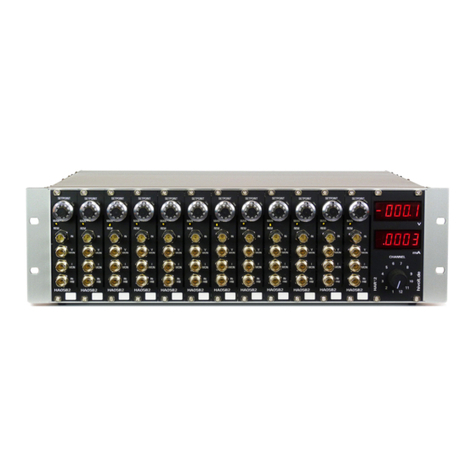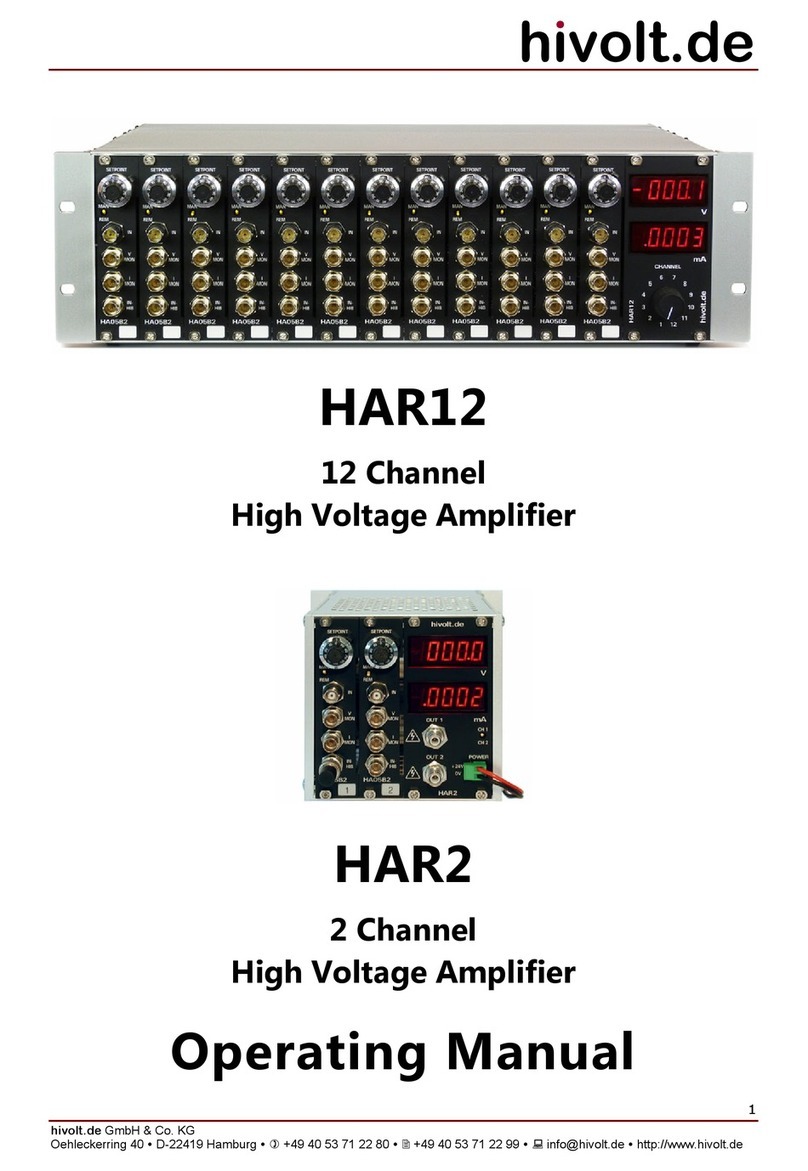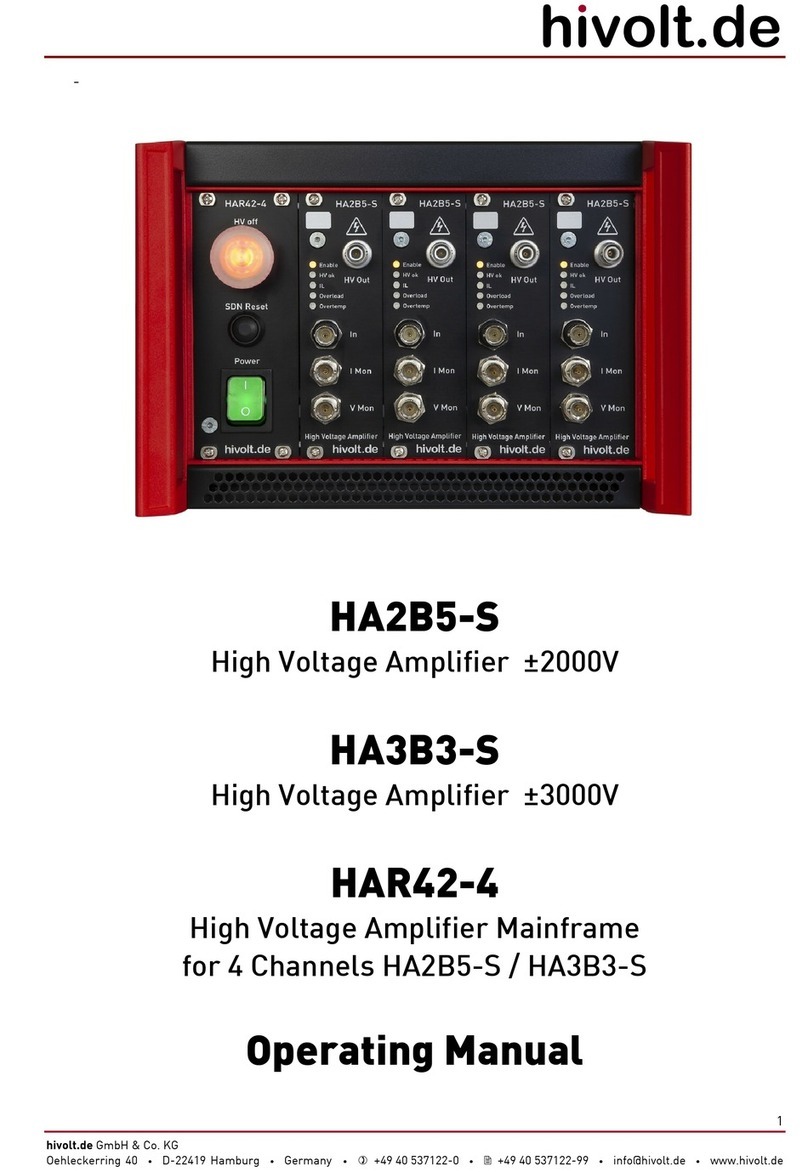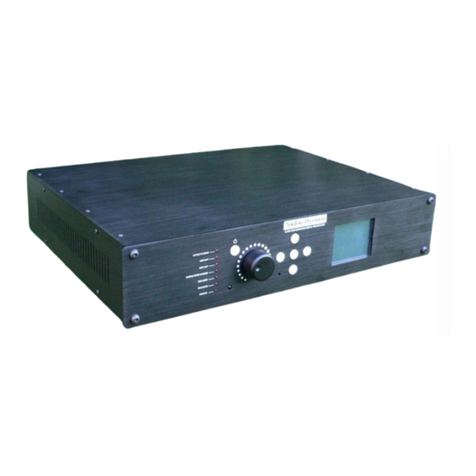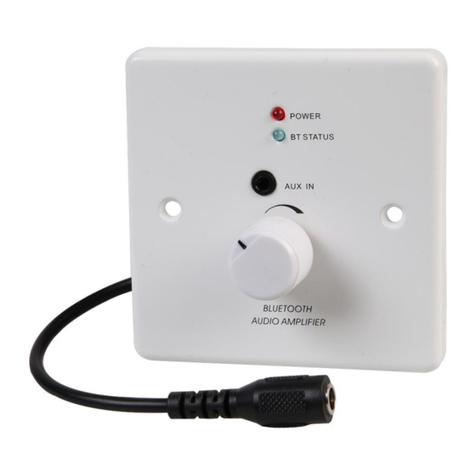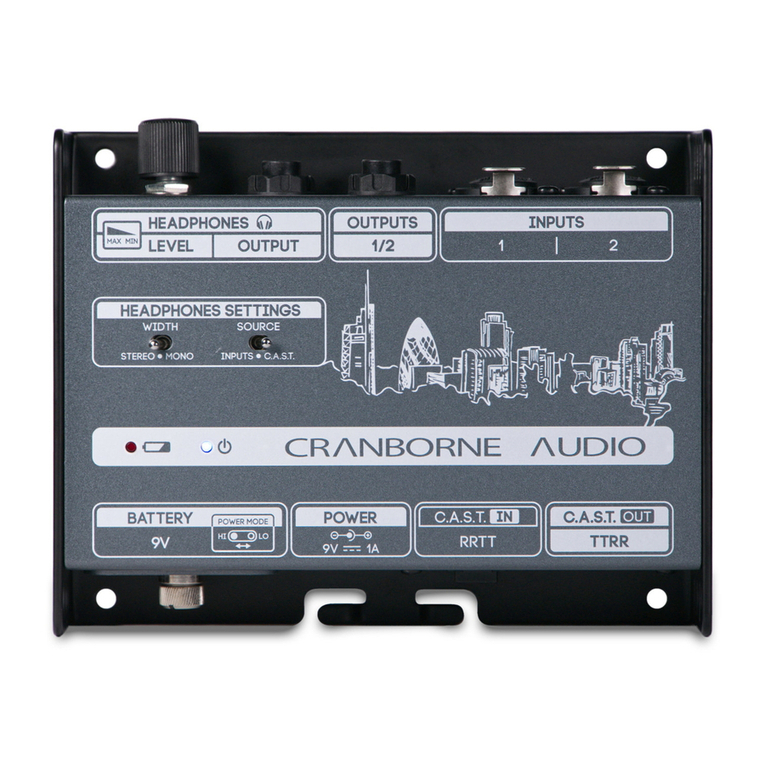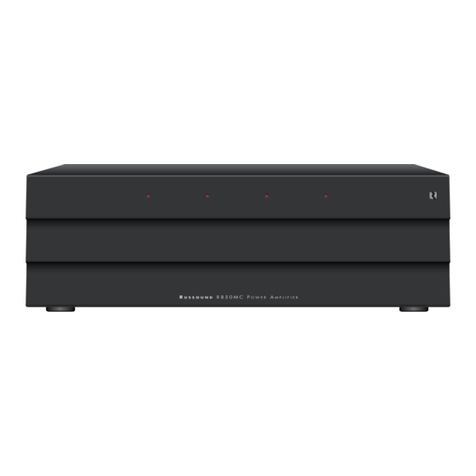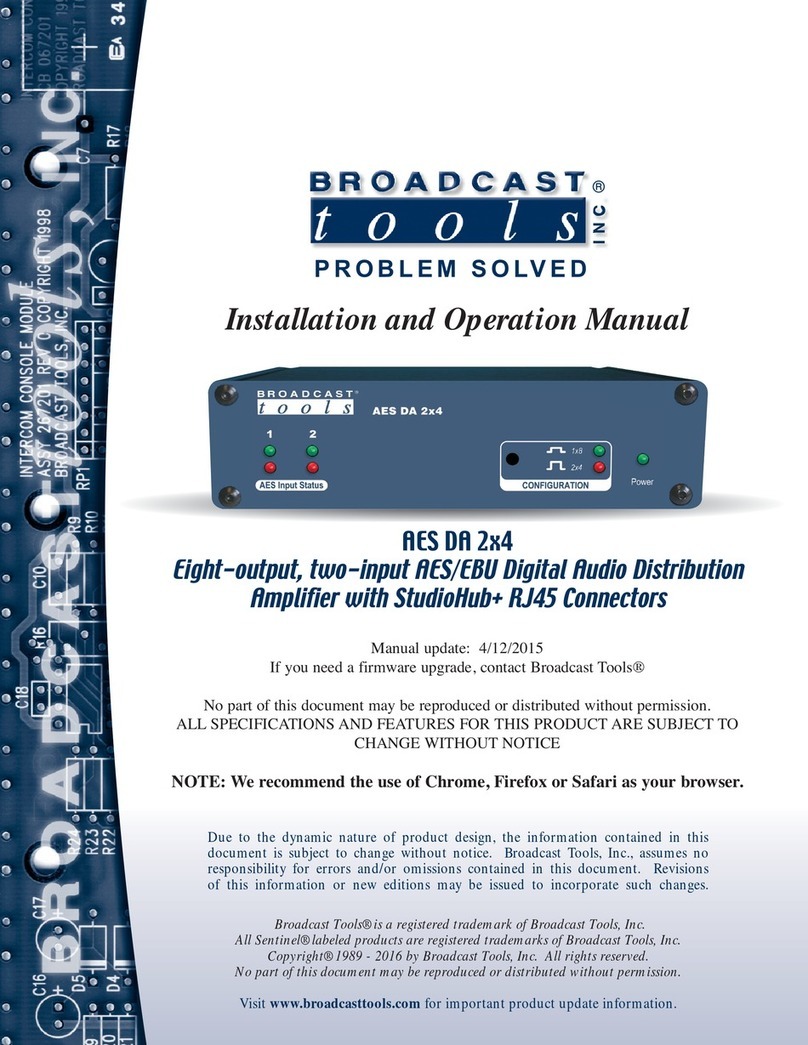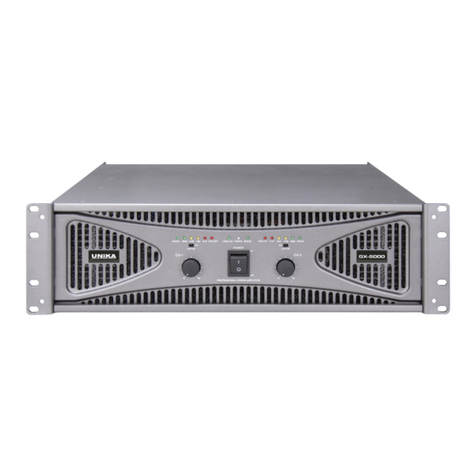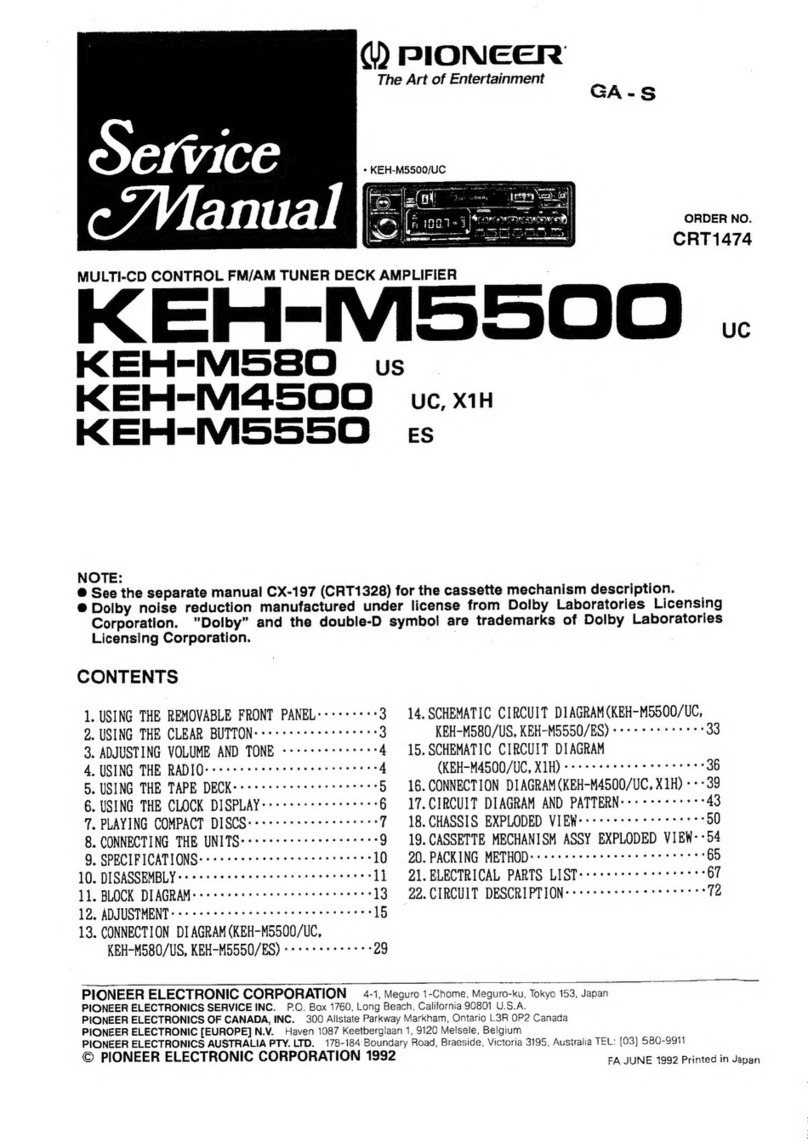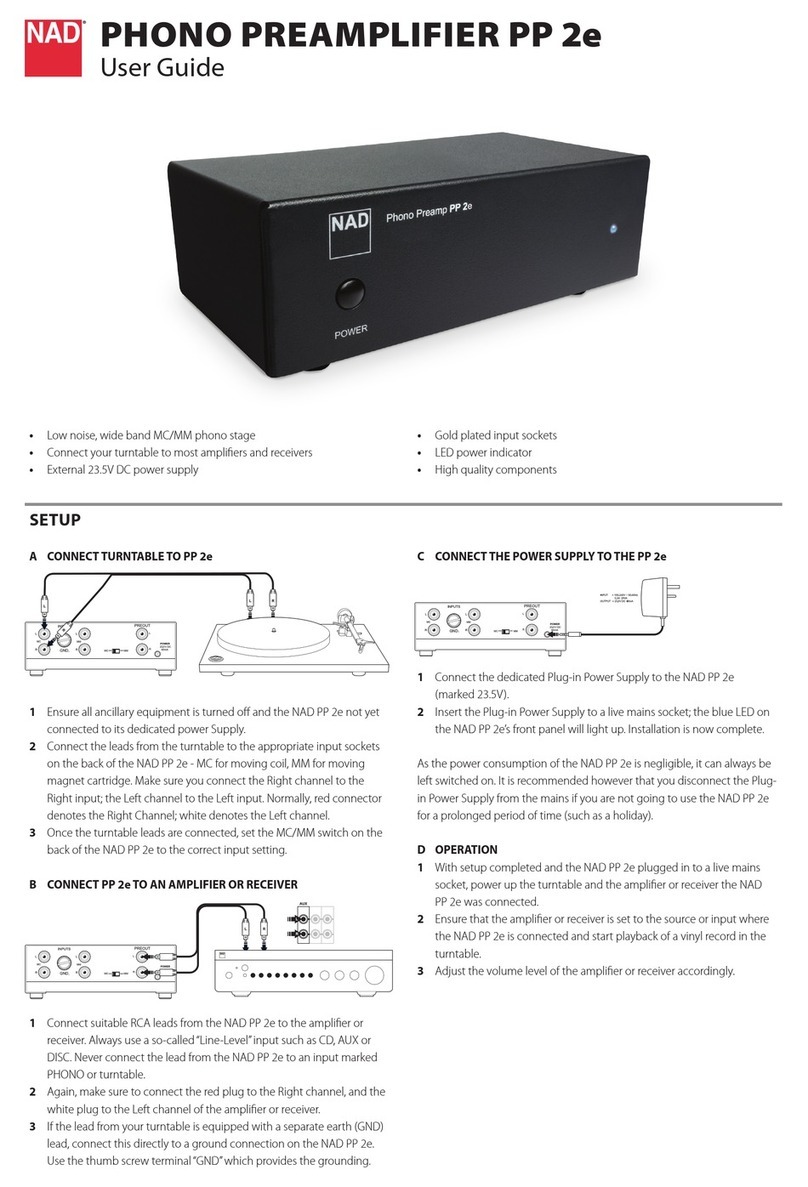hivolt HA61-3B30 User manual

1
hivolt.de GmbH & Co. KG
Oehleckerring 40 ∙D-22419 Hamburg ∙Germany ∙+49 40 537122-0 ∙+49 40 537122-99 ∙[email protected] ∙www.hivolt.de
HA61-3B30
High Voltage Amplifier ±3000V
Operating Manual

2
hivolt.de GmbH & Co. KG
Oehleckerring 40 ∙D-22419 Hamburg ∙Germany ∙+49 40 537122-0 ∙+49 40 537122-99 ∙[email protected] ∙www.hivolt.de
1WARNINGS 4
2OVERVIEW 6
3DESCRIPTION 6
3.1 Block Diagram 7
3.2 Control Voltage Input IN 8
3.3 Monitor Outputs V MON, I MON 8
3.4 Slew-Rate Limiter 8
3.5 PID Controller 8
3.6 Current Limit 9
3.7 Inhibit 9
3.8 Loading Conditions 10
3.9 Protection/Shutdown 10
3.10 LEDs 10
3.11 ON/OFF/Interlock 11
4TECHNICAL DATA 14
4.1 Frequency Response of Current Monitor 15
4.2 Ambient Conditions 15
4.3 Mechanical Specifications 15
5OPERATION 16
5.1 Initial Check 16
5.2 Warning Notices 16
5.3 Temperature Compensation 16
5.4 Installation 17
5.5 Mains Connection 17
5.6 Grounding 17
5.7 Ventilation 17
5.8 Initial Functional Test 18
5.9 INTERLOCK X2 18
5.10 Ethernet (ETH) X3 18
5.11 USB (COM) X4 19
5.12 TRIG/SYNC IN/OUT X6, X7 19
5.13 IN, VMON, IMON, INHIB X8, X9, X10, X11 19
5.14 High Voltage Output Connector HV OUT 19
5.15 Grounding 19
6COMMAND INTERFACE 20
6.1 Command Structure 20
6.2 Examples 20
6.3 Error Numbers 21
6.4 Command List 21
6.5 Model-Specific Parameter Ranges 24
6.6 Service Commands 24
6.7 Status Word 1 25
6.8 Status Word 2 26

3
hivolt.de GmbH & Co. KG
Oehleckerring 40 ∙D-22419 Hamburg ∙Germany ∙+49 40 537122-0 ∙+49 40 537122-99 ∙[email protected] ∙www.hivolt.de
6.9 Status Word 3 26
7SIGNAL GENERATOR 27
8SCPI PROTOCOL 27
9OPERATION / MAINTENANCE 27
9.1 Troubleshooting 27
9.2 Maintenance 28
9.3 Cleaning 28
9.4 Software Updates 29
10 DECLARATION OF CONFORMITY 31

4
hivolt.de GmbH & Co. KG
Oehleckerring 40 ∙D-22419 Hamburg ∙Germany ∙+49 40 537122-0 ∙+49 40 537122-99 ∙[email protected] ∙www.hivolt.de
1Warnings
Caution! This device produces lethal voltage above 3000V.
Please respect the following rules before every activation of the high voltage amplifier:
•The device should be operated only by qualified personnel, in accordance with the local
regulations and the instructions given in this manual.
•The device may only be operated as a component of an overall structure that fully complies with
the regulations for working with high voltage systems.
•Before switching the unit on, the experiment setup must be checked, and safety should be
assured. High voltage areas have to be blocked and secured.
•In case of suspected damage or malfunction, the device must immediately be put out of service,
and it must be secured against unintentional or accidental operation.
•The safety ground must always be connected! The ground screw on the rear panel must be
connected to the grounding point of the setup and to protective earth. Local regulations about
grounding should be taken into account.
•The output connectors must only be operated when the unit is switched off.
•High voltages may still exist even after the switch-off of the device due to capacitive charge!
Capacitances connected to the outputs of the device can possibly remain charged to dangerous
voltages, even after switching off the device.
•Before removing any covers disconnect the unit from the power supply!
•Before touching the output or working on the experimental setup, disconnect the unit from the
power supply!
•No wires or similar objects may project into the device through the ventilation slots
•Fuses have to be replaced by types indicated on the nameplate on the rear of the unit and in this
documentation.
Personal safety must be given the highest priority!

5
hivolt.de GmbH & Co. KG
Oehleckerring 40 ∙D-22419 Hamburg ∙Germany ∙+49 40 537122-0 ∙+49 40 537122-99 ∙[email protected] ∙www.hivolt.de
1 Warnhinweise
Achtung! Dieses Gerät erzeugt lebensgefährliche Spannungen über 3000V.
Vor jeder Inbetriebnahme des Hochspannungsverstärkers sind u. a. folgende Regeln zu beachten:
•Die Inbetriebnahme darf nur von einer Elektrofachkraft im Sinne der Berufsgenossenschaft der
Feinmechanik und Elektrotechnik vorgenommen werden.
•Vor der Inbetriebnahme muss die Bedienungsanleitung gelesen und verstanden worden sein.
•Es sind die einschlägigen Bestimmungen und Vorschriften des Gesetzgebers, der
Berufsgenossenschaft und des VDE zu beachten, insbesondere
-DIN-VDE 104 "Errichten und Betreiben elektrischer Prüfanlagen"
(s. auch BGI 891 "Errichten und Betreiben von elektrischen Prüfanlagen")
-Unfallverhütungsvorschrift DGUV Vorschrift 3 / BGV A3
"Elektrische Anlagen und Betriebsmittel"
•Das Gerät darf nur als Bestandteil eines im Ganzen den Vorschriften für den Umgang mit
Hochspannung genügenden Gesamtaufbaus betrieben werden!
•Vor jedem Einschalten des Geräts ist der Versuchsaufbau zu überprüfen und sicherzustellen, dass
es zu keiner Gefährdung kommen kann. Die Hochspannung führenden Bereiche müssen
vorschriftengerecht abgesperrt oder anderweitig gesichert sein!
•Sollte der Verdacht bestehen, dass das Gerät beschädigt ist oder Fehlfunktionen zeigt, ist es
umgehend außer Betrieb zu setzen und gegen beabsichtigten oder unbeabsichtigten Betrieb zu
sichern.
•Der Erdbolzen auf der Rückplatte des Geräts muss mit dem Zentralen Erdpunkt des
Versuchsaufbaus und dem Schutzleiter verbunden werden. Die örtlichen Vorschriften über Erdung
sind zu beachten.
•Die Ausgangssteckverbinder dürfen nur bei spannungsfrei geschaltetem Gerät betätigt werden!
•Bei Arbeiten am Versuchsaufbau oder bei Berühren der Ausgangsanschlüsse ist das Gerät zuvor
von der Spannungsversorgung zu trennen.
•Vor dem Öffnen des Geräts ist das Gerät von der Spannungsversorgung zu trennen.
•Es dürfen keine Objekte – wie Drähte o. ä. durch die Lüftungsschlitze in das Gerät Hereinragen.
•Im angeschlossenen Versuchsaufbau können evtl. vorhandene Kapazitäten auf Hochspannung
aufgeladen werden. Diese können auch nach Abschalten des Geräts noch gefährliche Spannungen
führen.
•Sollte ein Ersatz der Netzsicherungen erforderlich sein, so ist sicherzustellen, dass nur
Sicherungen der angegebenen Nennstromstärke und Nennspannung als Ersatz verwendet
werden.
Der Personensicherheit ist höchste Priorität einzuräumen!

6
hivolt.de GmbH & Co. KG
Oehleckerring 40 ∙D-22419 Hamburg ∙Germany ∙+49 40 537122-0 ∙+49 40 537122-99 ∙[email protected] ∙www.hivolt.de
2Overview
This manual covers the following models:
HA61-3B30-U 19"/3U single channel high voltage amplifier with simple command
interface via USB and Ethernet
HA61-3B30-G 19"/3U single channel high voltage amplifier with integrated DDS/ARB
signal generator and SCPI based command interface via USB and Ethernet
3Description
The HA61-3B30 is a fast precision high voltage amplifier with an optionally integrated signal generator
in a 19" rack mountable case. This single channel amplifier provides output voltages of -3000V to
+3000V at ±30mA (static) and >50mA peak (dynamic). The dynamic output current is available for
signal frequencies down to 1Hz.
The amplifier features high precision, high stability and very low noise. It is suitable to drive capacitive
and resistive-capacitive loads. It can easily drive loads like EAP actuators, electrorheological fluid
elements, electrostatic deflection electrodes and many other loads.
The internal PID-controller can be parametrized and thus be adapted to various load characteristics.
Power bandwidth and slew rate depend on the actual load capacitance.
A differential ±10V amplifier input prevents any ground loops and provides excellent noise
suppression.
The voltage gain is fixed to 300. Voltage and current monitor outputs are provided. One TTL compatible
INHIBIT input and one 24V compatible INH input are provided to quickly switch the output on and off.
The maximum output current can be limited to programmable values and programmable behavior.
When the output current reaches the threshold, the output will either shut down or the output current
will be limited to the set value.
Internal high voltage sources feed the output stage. The output stage is protected against overload,
short circuit, over temperature, transient overvoltage and high voltage flashover/arcing. The amplifier
output is made available via an SHV high voltage connector at the rear.
Operational and overload conditions are displayed on the front panel.
A safety interlock circuit with two redundant interlock lines is provided to integrate the unit into an
emergency shutdown circuit. When the interlock loop is opened, the internal high voltage sources are
shut down. In addition to the interlock inputs a HV OFF palm button is available on the front panel. The
red indicator lamp HV ON signals that the internal high voltage sources are switched on.
The internal high voltage sources can be switched on and off via the pushbuttons ON and OFF, via the
24V control signals ON and /OFF on the interlock interface or via software commands.
An isolated USB interface (COM) and an Ethernet interface (ETH) are provided, allowing the user to
control the amplifier via a simple command interface (parameterization of the slew-rate limiter and
the pid controller, setting of the output current limit, setting of the output voltage, voltage and current
monitoring, readout of temperatures and other operating parameters, amplifier configuration,...).

7
hivolt.de GmbH & Co. KG
Oehleckerring 40 ∙D-22419 Hamburg ∙Germany ∙+49 40 537122-0 ∙+49 40 537122-99 ∙[email protected] ∙www.hivolt.de
An implemented DDS/ARB signal generator is optionally provided (model HA61-3B30-G) to generate
standard waveforms like sine wave, trapezoid, square wave, pulse, sawtooth and noise as well as fully
arbitrary wave shapes. Parameters like waveform, amplitude, frequency, duty cycle, rise/fall time,
offset, DC value, current limit and further functional parameters are controllable via the command
interface. The integrated DDS/ARB signal generator is programmed via the COM or ETH interfaces
using the SCPI command protocol.
The internal waveform generator can be triggered and synchronized to other generators or signal
sources via the TRIG/SYNC connectors.
3.1 Block Diagram

8
hivolt.de GmbH & Co. KG
Oehleckerring 40 ∙D-22419 Hamburg ∙Germany ∙+49 40 537122-0 ∙+49 40 537122-99 ∙[email protected] ∙www.hivolt.de
3.2 Control Voltage Input IN
The BNC control voltage input IN is connected to a differential amplifier to suppress common mode
voltages between the external signal source and the amplifier (ground loops) It provides the analog
setpoint VONVA. The input can be adapted to the source impedance of the signal source by means of
the command SRS.
The input signal reference is connected via a 100Ωresistor to the amplifier signal ground and chassis
ground.
3.3 Monitor Outputs V MON, I MON
Two BNC monitor outputs provide actual values of output voltage and output current, both of which
are normalized to ±10 V.
The voltage monitor output V MON receives its signal via a compensated voltage divider and provides a
scaled image of the output voltages. The frequency response is linear up to well above the upper cut-
off frequency of the amplifiers. The frequency response of the I MON current monitor output is limited
to 30kHz in order to filter out the common mode ripple of the internal high voltage sources.
The monitor outputs are buffered (output impedance: 1kΩ) and short-circuit-proof. They are able to
drive capacitive loads (coaxial cables), but are not designed to drive cables with a low-impedance
termination.
The monitor values can also be read using the commands RCM,RVM,ROM.
3.4 Slew-Rate Limiter
A programmable slew-rate limiter is provided. It limits the slew-rate of the analog control signal
VONVA. The commands SCR and RCR are intended to control the slew-rate limiter.
Slew-rate limiter parameters:
SRLR_SP: slew-rate limiter rate [V\μs];
SRL_ENA: slew-rate limiter enable #
Disabling the slew-rate limiter results in maximum bandwidth of the analog input stage.
# this function is not available in the current version.
3.5 PID Controller
A programmable analog PID controller is provided to control the output voltage. By adjusting the PID
parameters, the controller can be optimized for the actual load characteristics.
The commands SCD, SCI, SCP, RCD, RCI and RCP are intended to adjust and monitor the PID control
parameters.
PID control parameters:
PIDD_SP: PID D-component; typically below 20; 0 switches off the D-part of the PID controller;
PIDI_SP: PID I-component; seven discrete steps; 0 switches off the I-part of the PID controller;
PIDI_L: PID I-limit; limits the influence of the I-component;
PIDP_SP: PID P-component; typically below 20;

9
hivolt.de GmbH & Co. KG
Oehleckerring 40 ∙D-22419 Hamburg ∙Germany ∙+49 40 537122-0 ∙+49 40 537122-99 ∙[email protected] ∙www.hivolt.de
3.6 Current Limit
By means of command SL1 the instantaneous value of the output current can be limited to a
programmable value. It can be set to a maximum of 60mA.
This is independent from the average output current shutdown limits, set by commands SL2 and SL3.
The shutdown limits are parametrized by two parameters: shutdown current limit and averaging time.
Positive and negative output currents are measured and averaged independently. When the averaged
positive or negative output current exceeds the programmed limit, the amplifier shuts down with
Overload.
The average limits can be set up to 30mA which equals the maximum DC output current of the
amplifier.
Parameters:
IO_LIM: instantaneous output current limit [mA];
IHVP_SDN_LIM: positive output current shutdown limit [mA];
IHVP_SDN_TIM: positive output current shutdown averaging time [ms]; eight discrete values;
IHVN_SDN_LIM: negative output current shutdown limit [mA];
IHVN_SDN_TIM: negative output current shutdown averaging time [ms]; eight discrete values.
These parameters can be set independently.
Limiting the instantaneous value of the output current will not result in a shutdown condition but it has
an influence on the dynamic behavior of the output. The reduced output current leads to reduced
output slew-rate and bandwidth. It might be necessary to adjust the PID control parameters.
Setting the instantaneous output current limit to maximum and setting the shutdown limits to lower
values can be used to protect sensitive loads while preserving the high dynamic capabilities of the
amplifier.
3.7 Inhibit
The high voltage amplifier output can be remotely switched off using the Inhibit functions. One TTL
compatible BNC INHIBIT input and one 24V compatible INTERLOCK.INH input on the INTERLOCK
connector are provided. In case of a HIGH signal on either input, the amplifier output is forced to 0V.
Inhibit can also be activated by using command ENA. The status of the enable condition can be read
from Status Word 1 (command RS1).
During Inhibit the internal high voltage sources are not turned off. The Inhibit functions can be used to
turn on and off the amplifier output relatively fast, independent from the analog input control signal.
The Inhibit functions are not suitable to achieve a safe state at the amplifier output. They must not be
used for safety relevant purposes.

10
hivolt.de GmbH & Co. KG
Oehleckerring 40 ∙D-22419 Hamburg ∙Germany ∙+49 40 537122-0 ∙+49 40 537122-99 ∙[email protected] ∙www.hivolt.de
3.8 Loading Conditions
The amplifier is designed to drive capacitive and resistive-capacitive loads.
The slew rate that can be achieved on the output depends on the load capacitance and the setting of
the instantaneous output current limit. The effective load capacitance CLconsists of the amplifier’s
internal output capacitance, the capacitance of the output cable (a typical coaxial cable: ca. 100pF/m)
and capacitance of the connected load.
The output stage can provide peak currents (IOP) of > ±50mAPfor up to 1s. The maximum static output
current is +30mA and -30mA.
Achievable slew rate: SR = IO/ CL[V/s].
If the maximum slew rate is exceeded, distortions occur in the output signals. In principle, the
amplifier should thus only be controlled by input signals that satisfy the achievable slew rate for a
given load. The slew-rate limiter (3.4) can be used for this purpose.
However, dynamic override of the inputs (e.g. control by square wave signals) is harmless. The edges
of the output waveform are nearly linear then with a slight overshoot.
Large capacitive loads driven by high frequency signals may result in a DC-offset superimposed on the
output voltage. This occurs if the final value of the desired output voltage can not be reached
periodically.
3.9 Protection/Shutdown
During operation,
- the interlock circuit,
- the average output current (positive and negative),
- overload of the high voltage sources,
- oscillation of the power stage #,
- overtemperature of the power stage and the high voltage sources,
- the condition of the internal auxiliary power supplies
are monitored. In the event of a fault, the high voltage supplies are switched off. The shutdown state is
latched and displayed on LEDs. The detailed shutdown condition is available from different status
words via the command interface (RS0…RS3).
A shutdown state can only be left by a shutdown reset: pushbutton SDN RST, signal INTERLOCK.SDR,
or command SRR.
After power on, the unit will be in shutdown state.
# this function is not available in the current version.
3.10 LEDs
LED Function
SYNC on: CLK synchronized to master via SYNC IN
pulsed: trigger signal received
(if internal ARB/DDS signal generator is implemented)
OVERLOAD flaring: overload limit (no shutdown yet)
blink: shutdown due to overload
OVERTEMP blink: shutdown due to overtemperature
pulsed: temperature warning (no shutdown yet)

11
hivolt.de GmbH & Co. KG
Oehleckerring 40 ∙D-22419 Hamburg ∙Germany ∙+49 40 537122-0 ∙+49 40 537122-99 ∙[email protected] ∙www.hivolt.de
OSC DET # on: power stage oscillating (no shutdown yet)
blink: shutdown due to oscillation
INTERLOCK on: shutdown: interlock circuit open
blink: shutdown due to interlock (IL circuit closed)
pulsed: interlock signal error
SHUTDOWN on: OFF state due to shutdown condition
pulsed: System error
ENABLE on: output stage is enabled by signal INHIBIT==L, signal INH==L and command
ENA
HV OK on: internal HV sources on and within ±10% tolerance limit
3.11 ON/OFF/Interlock
An independent safety interlock circuit with two redundant interlock lines is provided to integrate the
unit into an emergency shutdown circuit. When the interlock loop is opened, the internal high voltage
sources are shut down. In addition to the interlock inputs a HV OFF palm button is available on the
front panel. The palm button will be lit in red (ÀHV ON) to indicate that the high voltage sources are
switched on.
The internal high voltage sources can be switched on and off via the pushbuttons ON and OFF or via
the 24V control signals INTERLOCK.ON and INTERLOCK./OFF on the interlock interface or via
software command SHS. The high voltage can only be switched on when the Interlock shutdown state
is cleared by shutdown reset and the green light in the ON button is lit.
INTERLOCK connector X2
Pin Signal Level Dir. Function
1 +24V_IL 24V -> 24V output feeding the INTERLOCK signals; max. 150mA;
protected against overload
2 IL1 24V <- Interlock loop input; RI=400Ω
3 IL2 24V <- secondary Interlock loop input; RI=650Ω
4 ON 24V <- ON input; RI=400Ω
H => HV on (H pulse >100ms)
5 /OFF 24V <- OFF input; RI=1400Ω
L => HV off
6 SDR 24V <- Shutdown Reset input; RI=10kΩ;
H => Shutdown Reset (H pulse >100ms)
7 STS 24V -> Status output; short-circuit-proof; max. 10mA;
H == no Shutdown
8 INH 24V <- Inhibit input; RI=10kΩ;
H => output set to 0V (not suitable for safety relevant shutdown operation)
9 STS_HV 24V -> HV On Status output; conditionally short-circuit protected; max. 10mA;
H == HV generation active (not for safety relevant purposes)
10 GND GND
IL1, IL2: redundant Interlock / Emergency Stop inputs
Both inputs must be set to H level (24V) to facilitate switching on the high voltage sources.
The HV OFF button on the front panel is internally looped into signals IL1 and IL2.
If only one interlock / emergency stop path is used, route the signal to both inputs (IL1 and IL2).

12
hivolt.de GmbH & Co. KG
Oehleckerring 40 ∙D-22419 Hamburg ∙Germany ∙+49 40 537122-0 ∙+49 40 537122-99 ∙[email protected] ∙www.hivolt.de
ON, /OFF: On/Off control of the high voltage sources
The high voltage sources can be switched on and off by the signals ON and /OFF. The /OFF signal must
be set to H (24V) in order to switch on the sources via the ON signal.
On/Off control via ON and /OFF is provided as an alternative to control via front panel buttons (ON /
OFF) or the command interface.
If the ON/OFF control is not used, both inputs (ON and /OFF) must be set to H level. In this case the
high voltage sources are switched on as soon as the interlock circuits are closed (IL1 and IL2 at H
level). This operating mode involves a safety risk.
STS, SDR: Shutdown Status, Shutdown Reset
When an error occurs (interlock, overload, overtemperature...) the error status is stored (shutdown).
The shutdown status is reported via the status output STS.
The high voltage sources can only be switched on again after the shutdown latch has been reset via
the Shutdown Reset signal SDR, the SDN RST button or via the command SRR.
INH:
see 3.7.
STS_HV: Status HV generation active
The signal STS_HV carries H level when HV generation is active.
The signal must not be used as source for safety-relevant functions!
Operation using ON/OFF control
/OFF
STS
SDR
INH
GND
STS_HV
STS_HV
2
1
2
1
EMERGENCY
STOP
ON
OFF
X2
INTERLOCK
1
2
3
4
5
6
7
8
9
10
+24V_IL
SDR
IL1
STS
INH
GND
IL2
ON

13
hivolt.de GmbH & Co. KG
Oehleckerring 40 ∙D-22419 Hamburg ∙Germany ∙+49 40 537122-0 ∙+49 40 537122-99 ∙[email protected] ∙www.hivolt.de
Operation without using ON/OFF control
SDR
STS
/OFF
GND
INH
2
1
2
1
EMERGENCY
STOP
X2
INTERLOCK
1
2
3
4
5
6
7
8
9
10
SDR
+24V_IL
GND
STS
IL1
ON
IL2
INH
STS_HV
STS_HV
The device must be disconnected from the power supply before carrying out any operations on the test
setup or before touching the output terminals.

14
hivolt.de GmbH & Co. KG
Oehleckerring 40 ∙D-22419 Hamburg ∙Germany ∙+49 40 537122-0 ∙+49 40 537122-99 ∙[email protected] ∙www.hivolt.de
4Technical Data
Parameter Conditions
Mains voltage 95 – 265VAC
Mains frequency 47 – 63Hz
Input current VLine=115VAC, full load 5.3ARMS maximum
VLine=230VAC, full load 2.5ARMS maximum
Mains fuses F1, F2 T10A, 250V, IEC127-2/V
External fusing 16A
Protection category I
-Fuses F1, F2 are located within the mains connector unit on the rear.
-Signal ground and high voltage ground are connected to chassis ground / protective earth and the
earth connector (M4 nut).
-The appliance conforms to protection category I. It must only be used on mains power sockets with
a ground connection.
Parameter Conditions
Input voltage range Control input -10.0V – +10.0V
Max. safe input voltage ±18V
Input resistance 50kΩtyp.
DC gain 300 ±0.1%
Offset voltage RTO ≤±50mV
Output voltage range -3000V – +3000V
Load current range static -30mA – +30mA
Load current range dynamic, t < 0.6s -50mA – +50mA
Power bandwidth CL= 50pF, VO= 6000VPP,
THD ≤1%
DC – ≥15kHz *
DC – ≥1.6kHz #
Bandwidth CL= 50pF, VI= 2VPP -3dB DC – ≥50kHz *
DC – ≥16kHz #
Slew-Rate CL= 50pF ≥300V/μs * ≥30V/μs
Internal output capacitance < t.b.d. pF
Ripple, Noise CL= 500pF; 10Hz – 50kHz ≤50mVRMS *
Monitor output V RO= 1kΩ10V 3000V ±0.3%
Bandwidth monitor output V DC – ≥50kHz
Monitor output I RO= 1kΩ10V 100mA ±0.5%
Bandwidth monitor output I DC – ≥25kHz
-Signal ground and high voltage ground are connected to the chassis ground / earth terminal.
-Definition of full load: VO= 6000VPP, IO= 60mAP, f=100Hz, rectangular waveform.
*Bandwidth, slew rate and output noise are depending on the size of the capacitive load. The coaxial
output cable is part of the capacitive load and will reduce slew rate and large signal bandwidth.
A typical coaxial cable has a capacitance of approx. 100pF/m.
Increasing the load capacitance reduces output noise.
#in the current version the slew-rate is limited to 30V/μs maximum. This results in a power
bandwidth of 1.6kHz at 6000VPP output volage.

15
hivolt.de GmbH & Co. KG
Oehleckerring 40 ∙D-22419 Hamburg ∙Germany ∙+49 40 537122-0 ∙+49 40 537122-99 ∙[email protected] ∙www.hivolt.de
4.1 Frequency Response of Current Monitor
4.2 Ambient Conditions
Parameter Conditions Min. Max. Unit
Ambient temperature
- Operation
- Storage and Transportation
0
-25
+40
+70
°C
°C
Relative humidity
- Operation
- Storage and Transportation
Not condensing
5
5
80
95
%
%
-Depending on the ambient temperature, modulation amplitude and load capacitance, the maximum
output power may need to be derated.
4.3 Mechanical Specifications
Parameter Unit
Depth overall 475 mm
Depth case 417 mm
Width overall 484 mm
Width case 445 mm
Height 130.5 mm
Weight without amplifier modules 14.5 kg

16
hivolt.de GmbH & Co. KG
Oehleckerring 40 ∙D-22419 Hamburg ∙Germany ∙+49 40 537122-0 ∙+49 40 537122-99 ∙[email protected] ∙www.hivolt.de
5Operation
5.1 Initial Check
Once the product is delivered, please check the packaging and the device for possible transport
damage. Please check the device taken out of the packaging for any mechanical defects before the
unit is put into operation.
If the device has any signs of damage caused by transport, please immediately inform the shipping
company so that damages can be claimed.
5.2 Warning Notices
-For safe operation of this device it should be put into operation by a qualified electrician according
to this Operating Manual.
-The device may only be operated as a component of an overall setup that fully complies with the
regulations for working with high voltage systems.
-Output connectors may only be touched when the device is disconnected from the power supply!
Otherwise, there is a risk of electric shock.
-The test setup must be fully wired and protected against any contact before the device is put into
operation.
-The test setup must be checked each time before the device is put into operation to ensure that it
is not potentially dangerous. It should be checked that the high voltage connections are faultless
and the insulation of the wires is not damaged.
-The high-voltage areas must be blocked in accordance with regulations or secured by other
means.
-Once the test setup is connected, any existing capacitances can be charged to high voltage. They
may carry dangerous voltages even after the device is switched off.
-The ground bolt on the rear panel of the device must be connected to the central grounding point
of the test setup and to protective earth. Local regulations on grounding must be observed.
-No wires or similar objects may project into the device through the ventilation slots
-If it is suspected that safe operation is no longer possible, the device has to be taken out of
operation and secured against unintentional operation.
This symbol on the output terminals warns of the risk of electric shock.
5.3 Temperature Compensation
To avoid condensation within the device, it should be allowed to reach the room temperature. Please
unpack the product at least two hours prior to power-up.

17
hivolt.de GmbH & Co. KG
Oehleckerring 40 ∙D-22419 Hamburg ∙Germany ∙+49 40 537122-0 ∙+49 40 537122-99 ∙[email protected] ∙www.hivolt.de
5.4 Installation
The device is intended for operation on a laboratory bench or in a 19" cabinet.
When used in a 19" cabinet, the unit can be attached to the 19" spars by means of four mounting
screws or placed on mounting rails.
The mains switch must always be easily accessible.
5.5 Mains Connection
The connection to the low voltage network 230VAC / 50Hz is single-phase via an IEC plug.
Mains voltage range: 95 – 265VAC / 50/60Hz.
Caution: The unit must not be operated without being connected to protective earth!
Caution: Before connecting the unit to the mains, please check the available mains voltage.
The device may be damaged if operated with the wrong mains voltage.
5.6 Grounding
The M4 grounding nut and screw on the rear panel of the device must be connected to the central
grounding point of the test setup and to protective earth.
Local regulations on grounding must be followed.
5.7 Ventilation
Sufficient ventilation is required to remove the heat dissipated inside the case during operation. Air
intake is through air slits in the front panel. The warm air is blown-out by temperature-controlled fans
via the rear panel.
Sufficient space must be allowed for cooling air to reach the ventilation inputs on the front side and for
the fan exhaust air to exit from the rear of the unit. This is especially important if the amplifier is
mounted in a 19" rack.
No wires or similar objects may project into the device through the ventilation slots.

18
hivolt.de GmbH & Co. KG
Oehleckerring 40 ∙D-22419 Hamburg ∙Germany ∙+49 40 537122-0 ∙+49 40 537122-99 ∙[email protected] ∙www.hivolt.de
5.8 Initial Functional Test
Before the device is finally put into operation in a setup, a short functional test has to be carried out.
It is necessary that the interlock circuit is closed.
1. Make sure that the supply voltage is disconnected.
2. Remove all input signal cables and the output cable from the device.
3. Connect the terminal +24V IL (X2.1) to IL1 (X2.2), to IL2 (X2.3) and to /OFF (X2.5) on the
INTERLOCK connector by means of wire links.
4. Connect the mains supply voltage.
5. Switch on the POWER switch.
6. Release the HV OFF palm button.
7. The POWER switch will light up, SHUTDOWN and ENABLE LEDs will light up.
8. Push the SDN RST push button.
9. The SHUTDOWN LED will turn off, the ON push button will light up.
10. Push the ON push button.
Warning: Now High Voltage can be present at the output connector!
11. The HV OK LED will light up, the OFF push button and the HV OFF palm button will light up.
12. Push the OFF push button.
13. The HV OK LED, the OFF push button and the HV OFF palm button will turn off.
14. Push the ON push button again.
15. Push in the HV OFF palm button.
16. The HV OFF palm button and HV OK LEDs will turn off, the IL LEDs will light up.
17. Open the wire bridge to IL1 (X2.2) on the INTERLOCK connector.
18. Release the HV OFF palm button.
19. The Interlock LEDs will continue to light up.
20. Press the SDN RST push button.
21. The interlock status remains unchanged and the high voltage cannot be switched on.
22. Turn off the supply voltage.
5.9 INTERLOCK X2
Connector type: Phoenix Mini-Combicon, 10 circuits
Mating connector: Phoenix Mini-Combicon, 10 circuits, FK-MCP 1,5/10-ST-3,81 / 1851122
Pin assignment: see 3.11
5.10 Ethernet (ETH) X3
Connector type: RJ45
The Ethernet port ETH is provided for the command interface

19
hivolt.de GmbH & Co. KG
Oehleckerring 40 ∙D-22419 Hamburg ∙Germany ∙+49 40 537122-0 ∙+49 40 537122-99 ∙[email protected] ∙www.hivolt.de
5.11 USB (COM) X4
Connector type: USB B
The USB port COM is electrically isolated from GND to prevent ground loops (functional isolation).
The USB port COM is provided for the command interface and for software downloads.
Communication takes place via a virtual COM port on the USB port COM. A USB-to-UART module FTDI
FT231X is used in the device for the conversion.
To communicate with an application (terminal program or application software) a hardware driver and
a driver for the virtual COM port is required. Using Windows, the drivers are normally installed
automatically. If this is not initiated automatically, you can also download the drivers from
https://www.ftdichip.com/Drivers/VCP.htm and install then manually.
In the Device Manager, entries are displayed under “USB Controller:USB Serial Converter” and under
“Ports (COM&LPT):USB Serial Port (COMxx)”.
The baud rate is set to 115 kBd. It cannot be changed.
Format: no parity bit, 8 data bits, 1 stop bit (N,8,1). End of line: <cr> or <cr><lf>.
The device can be directly controlled via the COM port using a terminal program or it can be integrated
into a more complex application.
5.12 TRIG/SYNC IN/OUT X6, X7
Connector type: BNC
5.13 IN, VMON, IMON, INHIB X8, X9, X10, X11
Connector type: BNC
5.14 High Voltage Output Connector HV OUT
Connector type: SHV
The high voltage connector may only be mated or unmated when the supply voltage is switched off!
Otherwise, there is a risk of an electric shock.
5.15 Grounding
The M4 ground nut on the back panel of the device must be connected to the central grounding point
of the test setup and to protective earth.

20
hivolt.de GmbH & Co. KG
Oehleckerring 40 ∙D-22419 Hamburg ∙Germany ∙+49 40 537122-0 ∙+49 40 537122-99 ∙[email protected] ∙www.hivolt.de
6Command Interface
HA61 series high voltage amplifiers are equipped with one Ethernet (ETH) interface and one USB
(COM) interface. Both interfaces can be used to control and monitor the amplifier.
A simple command protocol (Level I Commands) with clear text ASCII commands using a request-
response structure is available to control and monitor the amplifier. Each command is followed by a
response.
Communication is alternatively via USB (COM) or ETH. The response is sent to the interface via which
the command was received.
Software download is is only possible via USB.
6.1 Command Structure
Request: $<id><com>[pars]<cr>[<lf>]
Response: $<err><id>[pars]<cr><lf>
$ Start character: "$"
id 1AN Sequence id: an alphanumeric character (not "$"); the id is returned with the
response for identification of the command sequence
com 3AN Command: three alphanumeric characters
pars AN Parameter: [;par[;par[;...]]]; optional, depending on the command.
Number format: [-]1234.56; leading zeros, decimal point and fractional digits
are optional.
Parameter separator: ";" (a semicolon is set preceding each parameter)
err 1N Error number
<cr> End of record: Carriage Return
<lf> End of record: Line Feed (optional)
6.2 Examples
Request: $1SRR<cr> Shutdown Reset; id=1
Response: $01<cr><lf> no error; id=1
Request: $ SV1;-2577.23<cr> Set Output Voltage: -2577.23V; id=' '
Response: $0 <cr><lf> no error; id=' '
Request: $5RAT<cr> Read Temperatures; id=5
Response: $05;35.7;42.3;61.5;64.3;67.5<cr><lf> no error; id=5; 35.7°C (HV1), 42.3°C (HV2),
61.5°C (PA1), 64.3°C (PA2), 67.5°C (PA3)
Request: $1XYZ<cr> invalid command; id=1
Response: $91<cr><lf> unknown command; id=1
Table of contents
Other hivolt Amplifier manuals
